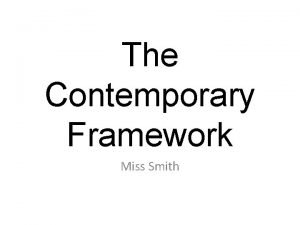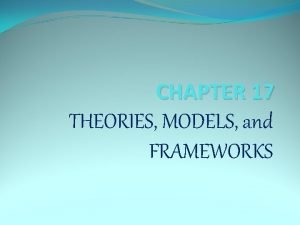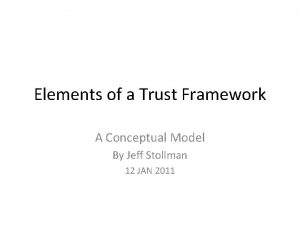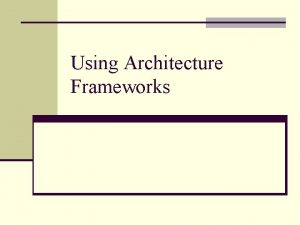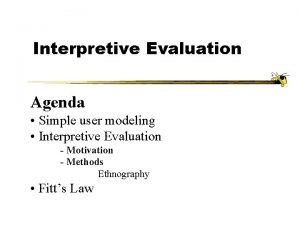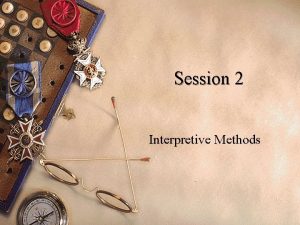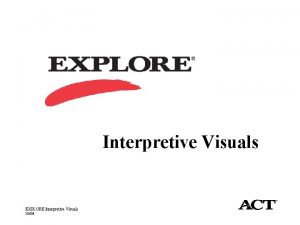Using Interpretive Frameworks to Teach Leadership International Leadership


















- Slides: 18

Using Interpretive Frameworks to Teach Leadership International Leadership Association Conference 2006 Friday, 3 November 2006, 9: 15 – 10: 15 am Presenters: Eileen Eckhart-Strauch and Jim Wolford-Ulrich, Ph. D. School of Leadership & Professional Advancement Duquesne University

About Duquesne University §Founded 1878 by Spiritan order of priests – Private (Catholic); coeducational §Distinctives of the Spiritan charism: – outreach, education, inclusivity §Over 10, 000 students in 10 Schools – 57% undergraduate / 43% graduate §School of Leadership & Professional Advancement (SLPA) founded in 1983 – Total current enrollment: 1, 011 students – Offers 2 bachelors degrees and 5 masters degrees §“We serve God by serving students" Using Interpretive Frameworks to Teach Leadership 2

SLPA Graduate Programs §Awards 5 graduate degrees in leadership – MA in Leadership & Liberal Studies – MS in Leadership & Business Ethics – MS in Leadership & IT – MS in Sports Leadership – MS in Community Leadership §Serves students in these formats: – Pittsburgh & Harrisburg: 183 students – Online: 335 students §MLLS 717 is required for all 5 degree programs Using Interpretive Frameworks to Teach Leadership 3

MLLS 717 Course History § § § “Leading People and Managing Relationships” Designed by faculty team January-April, 2005 – Offered every semester since Summer 2005 MLLS 717 enrollments: – – 158 students in 11 face-to-face sections 244 students in 18 online sections 10 faculty hold regular conference calls to review and exchange instructional practice and make curricular adjustments Using Interpretive Frameworks to Teach Leadership 4

Course Objectives § Integrate current theoretical and practical perspectives on leadership with your own practice of leading people and managing relationships. § Demonstrate effective use of self as an instrument of change. § Utilize interpretive frameworks when exercising organizational leadership. § Design strategies for realizing change in self and others through conscious intervention and personal influence. Using Interpretive Frameworks to Teach Leadership 5

Key Assignments §Learning Style Inventory §Leadership Strengths §My Best Self Reflection §Political Savvy Style §Feedback: “Me At My Best” / Reflection §Vignette(s) / Mini-Case(s) §Be the Change / “My Best Self” Speech §Leadership Development Plan Using Interpretive Frameworks to Teach Leadership 6

What Are Interpretive Frameworks? § Framework: – a structure designed to support or hold something together § Interpretation: – explaining or giving meaning to something A leadership interpretative framework is a structure, built around an idea or a set of related concepts or principles, that provides a particular focus for explaining or giving meaning to the act of leading. Using Interpretive Frameworks to Teach Leadership 7

Leaders and Sense Making § “Sense-making” is what leaders do (Weick) – Focus on cues in the environment – Use frameworks to construct meaning, to explain, and to deal with surprise – Interact to produce mutual understanding – Recognize patterns of experience – Explore the plausibility of possible interpretations § They make sense of reality: – Retrospectively and prospectively – In collaboration with others – On an ongoing basis Using Interpretive Frameworks to Teach Leadership 8

Framing: A Leader Skill Organizational Frames: Examples § Bolman & Deal – Four Framework Approach –Structural –Human Resource –Political –Symbolic § Fairhurst & Sarr – Ways of Framing Situations –Metaphor –Stories –Traditions –Slogans –Artifacts –Contrast –Spin Bolman & Deal, 1991; Fairhurst & Sarr, 1996. Using Interpretive Frameworks to Teach Leadership 9

Implicit Interpretive Frameworks Other Examples § Situational Leadership – Four leadership styles: • Directing, Coaching, Delegating, Supporting – Leader must interpret team behaviors to assess levels of competence & commitment § Servant Leadership – Leader interprets what followers need § Kelley’s Followership Model – “Sheep, ” “yes people, ” “alienated, ” “effective” – Leader interprets participation & critical thinking Using Interpretive Frameworks to Teach Leadership 10

Vignette Materials Developed §Teaching notes §Sample vignette §Vignette response rubric §Response to sample (with feedback) §Vignette A – “Leading Up” §Vignettes B 1 and B 2 – “Leading Out” §Sample student responses with instructor feedback Using Interpretive Frameworks to Teach Leadership 11

Feedback from Students § § “Life is a series of leadership vignettes. It's very useful. Not everything is a huge term paper, or a major event. Big progress is often made in a series of small ways. ” “They are great examples to make you think about how you would handle a situation while still in a controlled environment. ” “It paints the picture of what we are discussing. ” “The challenges described in my vignette are typical of those I face on a regular basis. ” When asked in a post-course survey if vignettes should be kept as part of the course, 79% of respondents indicated “Yes. ” Using Interpretive Frameworks to Teach Leadership 12

Faculty Perceptions § “Vignettes permit me to develop case study examples specific to the needs and interests of the students. ” § “Vignettes are a great alternative to standard testing, as they allow me to better assess the progress that each student has made. ” § “Students appreciated the opportunity to put into practice theories we have covered in the course” § “Students indicated the vignettes helped them to pull everything together in the course. ” Using Interpretive Frameworks to Teach Leadership 13

Lessons Learned § Embed interpretive frameworks in the rubric, and tie the rubric to course objectives. § Give multiple examples of what is desired; explain the rubric (and frameworks) carefully. § Encourage students to: – View leadership as “authorship”: they are designing a solution that fits their strengths & style. – Integrate frameworks into their leadership practice. § Vignettes can be useful in helping online students make effective application of leadership concepts, models and theories. Using Interpretive Frameworks to Teach Leadership 14

Discussion Using Interpretive Frameworks to Teach Leadership 15

Key Course Texts § Clifton, D. , & Buckingham, M. (2001). Now discover your strengths. New York: Free Press. § De. Luca, J. R. (1999). Political savvy: Systematic approaches to leadership behind the scenes. Berwyn, PA: Evergreen Business Group. § Goleman, D. , Mc. Kee, A. , & Boyatzis, R. E. (2002). Primal leadership: Realizing the power of emotional intelligence. Boston: Harvard Business School Press. § Hammond, S. A. (1998). The thin book of appreciative inquiry (2 nd ed. ). Plano, TX: Thin Book. § Jackman, J. M. , & Strober, M. H. (2003). Fear of feedback. Harvard Business Review, 81(4), 101 -107. § Koestenbaum, P. (1991). The leadership diamond: Four strategies for greatness. In Leadership: The inner side of greatness (pp. 83 -104). San Francisco: Jossey-Bass. Using Interpretive Frameworks to Teach Leadership 16

Presentation References Bolman, L. G. , & Deal, T. E. (1991). Reframing organizations. San Francisco: Jossey-Bass. Burrell, G. , & Morgan, G. (1979). Sociological paradigms and organizational analysis. London: Heineman. Fairhurst, G. T. , & Sarr, R. A. (1996). The art of framing: Managing the language of leadership. San Francisco: Jossey-Bass. Kish, M. H. Z. (2004). Using vignettes to develop higher order thinking and academic achievement in adult learners in an online environment. (Doctoral dissertation, Duquesne University, 2004). Pro. Quest Dissertations and Theses. (AAT 3145405) Smircich, L. , & Morgan, G. (1982). Leadership: The management of meaning. Journal of Applied Behavioral Science, 18(3), 257 -273. Weick, K. E. (1995). Sensemaking in organizations. Thousand Oaks, CA: Sage. Using Interpretive Frameworks to Teach Leadership 17

Additional Information § Handouts and vignette materials package may be downloaded from: http: //www. inflectionpoints. com/ILA § Presenter Contact Information: – Eileen Eckhart-Strauch • Phone: 1 -717 -676 -1186 • E-mail: eckhartstrauche@duq. edu – Jim Wolford-Ulrich, Ph. D. • Phone: 1 -412 -396 -1640 • E-mail: ulrich@duq. edu Using Interpretive Frameworks to Teach Leadership 18
 What is interpretive framework
What is interpretive framework Interpretive framework examples
Interpretive framework examples Arnoldo hax
Arnoldo hax Topic sentence
Topic sentence High art vs low art
High art vs low art Parcc model content frameworks
Parcc model content frameworks Nursing theories and conceptual frameworks
Nursing theories and conceptual frameworks Java ecommerce framework
Java ecommerce framework List of theoretical frameworks
List of theoretical frameworks Architecture frameworks
Architecture frameworks Nursing informatics theories, models and frameworks
Nursing informatics theories, models and frameworks Enterprise agile frameworks
Enterprise agile frameworks Why i hate frameworks
Why i hate frameworks Social studies toolkit
Social studies toolkit Food security concepts and frameworks
Food security concepts and frameworks Describe trust frameworks.
Describe trust frameworks. Actor frameworks
Actor frameworks Aitchison labelling packaging network building
Aitchison labelling packaging network building Software architecture frameworks
Software architecture frameworks




